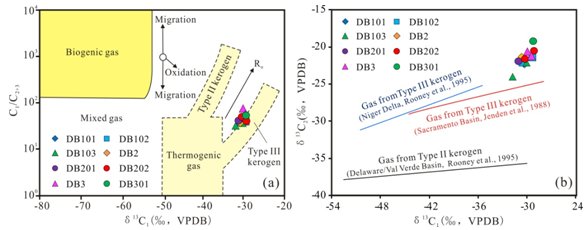太阳官网教师魏强博士以第一作者在ENERGY EXPLORATION & EXPLOITATION(JCR 3区)在线发表题为“Hydrocarbon geochemistry and charging history of the deep tight sandstone reservoirs in the Dabei Gas Field, Kuqa Depression, Tarim Basin, NW China” (DOI:10.1177/0144598720919808)的论文。该研究工作得到了古天乐太阳娱乐集团tyc493博士科研启动基金项目(编号:2019jb20)、国家科技重大专项项目(编号:2016ZX05007-003)及国家自然科学基金项目(编号:U1810201, 41572125)支持。
论文摘要:
The geochemical, feature and evolutionary history of hydrocarbons from the deep Cretaceous Bashijiqike (K1bs) Formation tight sandstone reservoir in the Dabei Gas Field, Kuqa Depression were investigated using gas chromatography (GC), GC–Mass Spectrometry (GC–MS), hydrocarbon generation kinetics, inclusions petrography and micro-thermometry, laser Raman spectroscopy, and quantitative grain fluorescence (QGF). The result indicates that natural gases from the deep sandstone reservoir are mainly composed of alkanes and belong to dry gases, of which methane accounts for 94.30% to 97.20% (avg. 95.64%), and ethane is 1.23% to 2.45% (avg. 1.95%). The stable carbon isotopic value of methane and ethane is −31.9‰ to −29.3‰ (avg. −30.3‰) and −24.2‰ to −19.4‰ (avg. −21.7‰), respectively, this reflects the features of high-mature coal-formed gases.In addition, natural gases in the Dabei Gas Field have characteristics of coal-derived gases which were sourced from Jurassic coal measures.Oils in the Dabei Gas Field predominately originated from Triassic Huangshanjie (T3h) Formation mudstones with some contributions from Jurassic coaly rocks.Petrological and micro-thermometry results of fluid inclusions suggest that the K1bs Formation tight sandstone reservoirs have experienced two phases of hydrocarbons charge histories, namely “early oil and later gas”. The QGF analysis indicated that sandstone samples with QGF index value >5 and QGF-E intensity >40 pc in Wells DB101 and DB2 can be used as indicators for the paleo oil layers or the migration channels of later charged natural gas. The aforementioned analyses and burial and thermal histories of K 1bs sandstone reservoir demonstrated that oil charged at 10 Ma and natural gas charged at approximately 3 Ma in the study area. Furthermore, paleo tectonic evolution enabled source rocks to mature and expel hydrocarbons, and the structurally related faults and traps provided pathways and places for hydrocarbon migration and accumulation.

Figure Genesis distinction diagram of natural gases in the Dabei Gas Field.